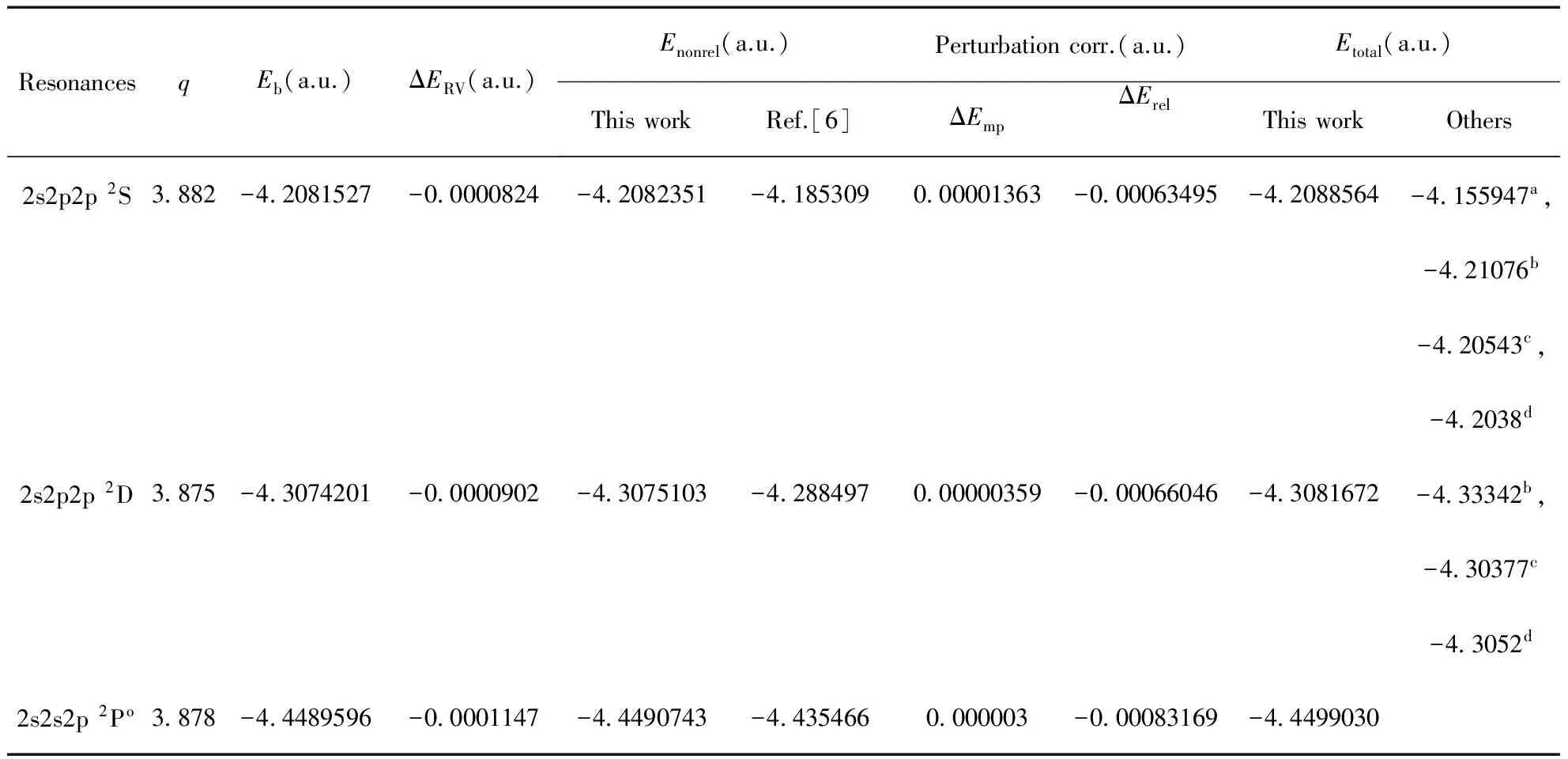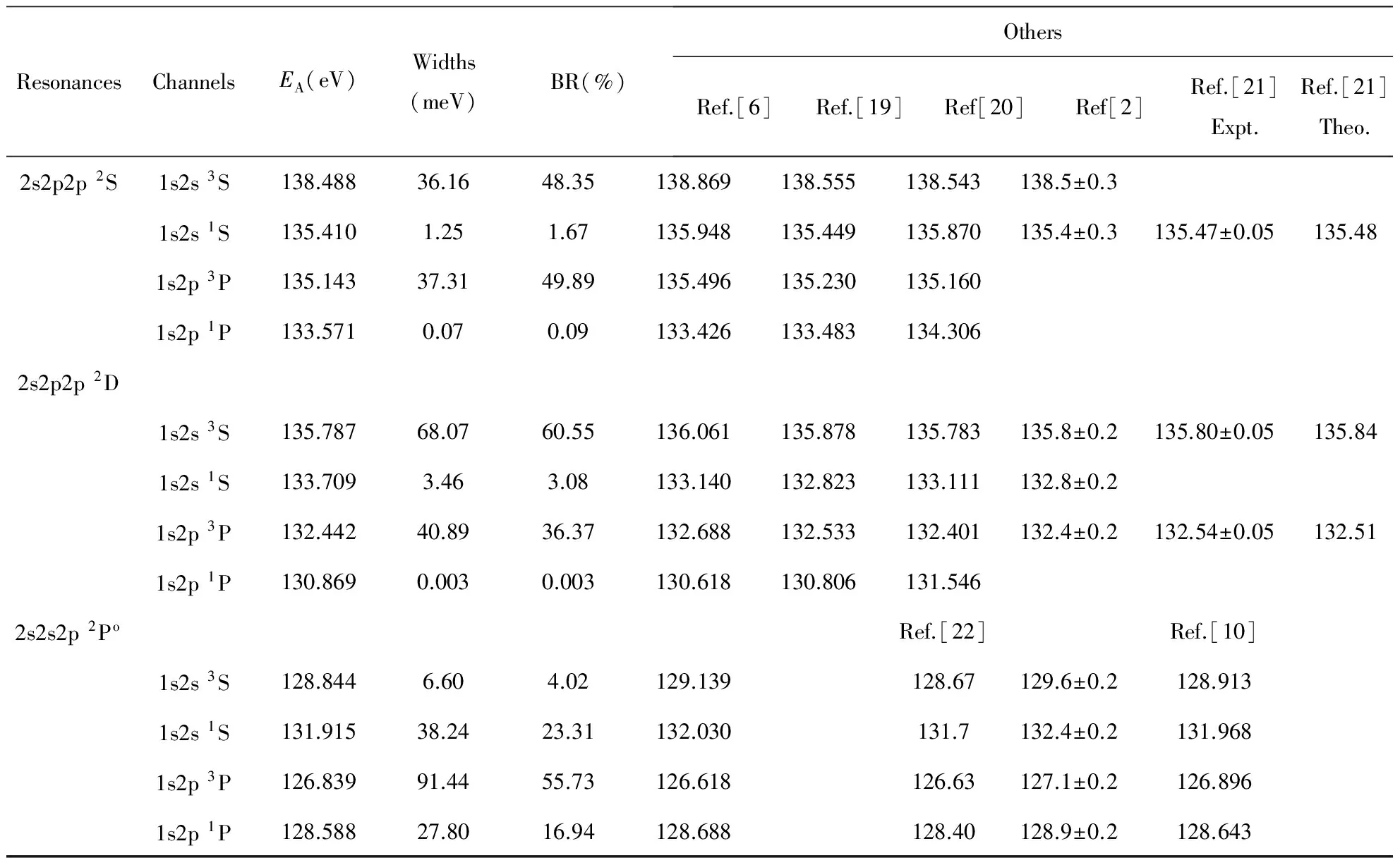类锂离子内壳激发态的能量、俄歇宽度和俄歇分支率
朱婧晶
(西安电子科技大学物理与光电工程学院, 西安 710071)
类锂离子内壳激发态的能量、俄歇宽度和俄歇分支率
朱婧晶
(西安电子科技大学物理与光电工程学院, 西安 710071)
采用鞍点变分方法和鞍点复数转动方法并考虑相对论修正和质量极化效应,计算了类锂离子内壳激发态的能量、俄歇宽度、俄歇分支率和俄歇电子能量.进一步采用截断变分方法饱和空间波函数.计算结果与其他理论结果以及实验数据符合得很好.
类锂离子; 俄歇宽度; 俄歇分支率; 鞍点变分方法
1 Introduction
The “hollow” states, also referred to triply excited states have recently been the subject of intense experimental and theoretical interest. They are triply excited atoms with two vacancies in theKshell. The triply excited four-body Li-like atomic system is an ideal system for investigating the electron correlation and for testing theoretical methods in dealing with such problems.
The triply excited states of Li-like beryllium were reported by Bruch and co-workers[1, 2]in beam-foil experiments. In 1984, Agentoftatal.[3]reported the first observation of the decay of Be+2p2p2p4Soin an optical emission spectrum. In 1994, Kiernanetal.[4]measured the energy and width of the 2s22p2Postate. Theoretically, The energies and configuration mixings of the triply excited states of the Li-like isoelectronic sequence (Z=3-10) have been calculated by Conneely and Lipsky[5,6]using the truncated diagonalization method (TDM). The multiconfiguration Hartree-Fock[7]method, Dirac-Fock method[8], the saddle-point complex-rotation method[9-11], R-matrix[12-14], and the density functional theory(DFT)[15]methods have also been used to calculate the energies and widths of the triply excited states of Li-isoelectronic sequence.
In this work, three triply excited sates 2s2p2p2S,2s2p2p2D and 2s2s2p2Poof Be+are studied. The resonance energies, Auger channel energies, widths and Auger branching ratios are calculated with the saddle-point variational method and saddle-point complex-rotation method. A restricted variational method is used for the saturated wavefunctions. Relativistic corrections and mass polarization are also computed using the first-order perturbation theory.
2 Theory
In theLScoupling scheme, the nonrelativistic Hamiltonian for the Li-like ions is given by (in a.u.)
(1)
In general, the closed-channel wavefunction of the triply excited three-electron system can be written as
Ψb(1,2,3)=A[1-P(1)][1-P(2)][1-P(3)]ψ(1,2,3)
(2)
whereAistheantisymmetrizationoperator.TheprojectionoperatorPis given by
(3)
where the vacancy orbital is
φ0(r)=Nexp(-qr)
(4)
qis the nonlinear parameter determined in the energy maximization process,Nis a normalization constant. The radial basis functions inψ(1,2,3)areSlaterorbitals.Thelinearandnonlinearparametersinψ(1,2,3)aredeterminedintheenergyoptimizationprocesses.EbobtainedfromtheΨb(1,2,3)isthesaddle-pointenergyofthetriplyexcitedstates.Thetotalenergyisfurtherimprovedbyincludingthemasspolarizationeffectandrelativisticcorrectioncalculatedusingfirst-orderperturbationtheory.Therelativisticperturbationoperatorsconsideredinthisworkarecorrectiontothekineticenergy(P4),Darwinterm,electron-electroncontactterm,andorbit-orbitinteraction.TheexplicitexpressionsfortheseoperatorsaregiveninRef.[16],andtheywillnotberepeatedhere.
Tosaturatethefunctionalspace,therestrictedvariationalmethod[16]isusedtofurtherimprovesaddle-pointenergyEb, the nonrelativistic energy is obtained by adding improvement from the restricted variationΔERV.
Finally, we obtain the energy of the resonance:
Etotal=Eb+ΔERV+ΔErel+ΔEmp
(5)
Toobtainthewidthsthatcomesfromtheinteractionoftheclosed-channelwiththeopen-channelusingthesaddle-pointcomplex-rotationmethod,wewritethetotalwavefunctionas
(6)
where
(7)
here φi( 1,2) represents the two - electron open - channel target state,Ui represents the wavefunction of the outgoing electron. In the complex - rotation computation, only r in Uiis complex scaled. The energy from Ψ( 1,2,3) ,E - iΓ/2 ,gives the position and the width of the resonance.
3 Result and discussion
Table1givesthenonrelativisticenergiesandrelativisticenergiesofthetriplyexcitedstates2s2p2p2S, 2s2p2p2Dand2s2s2p2PoforLi-likeberyllium.qis the nonlinear parameter in the vacancy orbital determined in the energy maximization process and can be roughly interpreted as the effective nuclear charge seen by the 1s-vacancy orbital.Ebis the enegy calculated from the closed-channel wavefunction. ΔERVis the total correction toEbfrom the restrictive variation calculations. As Table 1 shows, for all cases, the nonrelativistic energies in this work are lower than those of Conneelyetal(TDM)[6]. Using first-order perturbation theory, we calculate the mass polarization, the relativistic correction to the kinetic energy (P4), the Darwin term, the orbit-orbit interaction, and electron-electron contact term. ΔEmpis the mass polarization and ΔErelis the relativistic correction. The relativistic energies in this work are lower than those of Ahmed M and Lipsky L[17], Davis B F and Chung K T.[19], Zhou Z Y and Chu S -I.[20]. For example, for 2s2p2p2S state, the relativistic energies in this work is -4.2088564a.u., which is -4.155947a.u.in Ref.[17], -4.20543a.u.in Ref.[19] and -4.2038a.u.in Ref.[20].
Table 2 gives the Auger channel energies, the Auger widths and Auger decay ratios of triply excited states2S,2D, and2Pofor Li-like beryllium. These states can decay via many channels, we have calculated only the 1s2s1,3S, 1s2p1,3P Auger channel energies in this work because they are the only Auger channels relevant to the experimental and other theoretical results. We also list the other theoretical and experimental data to examine the calculation precision for triply excited states. For 2s2p2p2S, the branching ratios are
2s2p2p2S → 1s2s3S +ks (138.488, 48.35%)
→ 1s2s1S (ks (135.410, 1.67%)
→ 1s2p3P (kp (135.143, 49.89%)
→ 1s2p1P (kp (133.571, 0.09%)
here ks and kp represent the Auger electron with angular momentuml. They agree with line 45 at 138.5±0.3 and line 42 at 134.5±0.3.We can get the Auger branching ratios by the Auger widths Knowledge of the Auger branching ratios of triply excited states plays an important role in understanding the stabilization of the states formed in collisions between multiply charged ions with atoms, molecules and surfaces. The information from Table 2 is very useful in the study of Auger spectra. It is our hope to provide more reliable theoretical data to stimulate further experimental measurements.
4 Conclusion
In this work, we have computed the relativistic energies, Auger widths, Auger channel energies and Auger branching ratios of the triply excited states2S,2D, and2Pofor Li-like beryllium using saddle-point variational method and saddle-point complex-rotation method. The energies obtained in this work are much lower than those of the other theoretical data. The Auger channel energies are in good agreement with other theoretical and experimental data. We hope these available theoretical data should be useful for studying the observed spectrum in future experiments.

Table 1 Nonrelativistic energies, Relativistic energies of triply excited states 2S, 2D, and 2Po for Li-like beryllium. q is the nonlinear parameter in the vacancy orbital. ΔEmp is the mass polarization and ΔErel is the relativistic correction
a.Ref.[17]; b.Ref.[18]; c.Ref.[19]; d.Ref.[20]

Table 2 Auger channel energies, the Auger widths and Auger branching ratios of triply excited states 2S, 2D, and 2Po for Li-like beryllium
[1] Bruch R, Paul G, Andrä J,etal. Autoionization of foil-excited states in LiⅠand LiⅡ[J].Phys.Rev. A, 1975, 12: 1808.
[2] Rφdbro M, Bruch R, Bisgaard P. High-resolution projectile Auger spectroscopy for Li, Be, B and C excited in single gas collisions I. Line energies for prompt decays[J].J.Phys. B, 1979, 12: 2413.
[3] Agentoft M, Andersen T, Chung K T. Optical emission from the (2p2p2p)4S0states in three-electron systems[J].J.Phys. B, 1984, 17: L433.
[4] Kiernan L M, Kennedy E T, Mosnier J P,etal. First observation of a photon-induced triply excited state in atomic lithium[J].Phys.Rev.Lett., 1994, 72: 2359.
[5] Conneely M J, Lipsky L. Energy levels and classifications of triply excited states of N4+,O5+,F6+, and Ne7+[J].At.DataNucl.DataTables, 2004, 86: 35.
[6] Conneely M J, Lipsky L. Energy levels and classifications of triply excited states of Li, Be+, B2+, and C3+[J].At.DataNucl.DataTables, 2002, 82: 115.
[7] Piangos N A, Nicolaides C A. Radiative lifetimes of triply excited states of the Li isoelectronic sequence[J].Phys.Rev. A, 1993, 48: 4142.
[8] Azuma Y, Hasegawa S, Koike F,etal. New photon-induced triply excited hollow atom states of lithium[J].Phys.Rev.Lett., 1995, 74: 3768.
[9] Chung K T, Gou B C. Energies and lifetimes of triply excited states of lithium[J].Phys.Rev. A, 1995, 52: 3669.
[10] Gou B C, Chung K T. Energy and lifetime of triply excited states of lithium-like beryllium and carbon[J].J.Phys. B, 1996, 29: 6103.
[11] Zhang Y, Chung K T. Even-parity triply excited states of lithium[J].Phys.Rev. A, 1998, 58: 1098.
[12] Journel L, Cubaynes D, Bizau J M,etal. First experimental determination and theoretical calculation of partial photoionization cross sections of lithium over the energy region of hollow atomic states[J].Phys.Rev.Lett., 1996, 76: 30.
[13] Diehl S, Cubaynes D, Wuilleumier F J,etal. Experimental observation and theoretical calculations of rydberg series in hollow lithium atomic states[J].Phys.Rev.Lett., 1997, 79: 1241.
[14] Berrington K, Nakazaki S. Direct and indirect ionization processes near the Li ‘hollow-atom’ threshold[J].J.Phys. B, 1998, 31: 313.
[15] Roy A K. Density functional studies on the hollow resonances in the Li-isoelectronic sequence(Z=4-10)[J].J.Phys. B, 2005, 38: 1591.
[16] Zhu J J, Gou B C, Wang Y D. Energies, fine structure, hyperfine structure and Auger widths of the core-excited states for the Li isoelectronic sequence[J].J.Phys. B, 2008, 41: 065702.
[17] Ahmed M, Lipsky L. Triply excited states of three-electron atomic systems[J].Phys.Rev. A, 1975, 12: 1176.
[18] Safronova U I, Senashenko V S, Autoionising states of three-electron atomic systems[J].J.Phys. B, 1978, 11: 2623.
[19] Davis B F, Chung K T. Identification of doubly- and triply-excited Be+resonances in a high-resolution Auger spectrum[J].J.Phys. B, 1982, 15: 3113.
[20] Zhou Z Y, Chu S I. Spin-dependent localized Hartree-Fock density-functional calculation of singly, doubly, and triply excited and Rydberg states of He- and Li-like ions[J].Phys.Rev. A, 2005, 71: 022513.
[21] Bruch R, Merabet H, Chung K T. Excitation of triply excited Be+(2lnl’n’l’’) states in 300 and 500 keV-Be++CH4collisions[J].Nucl.Instrum.Methods.Phys.Res.Sect. B, 2003, 205: 488.
[22] Safronova U I, Bruch R. Triply excited states of the lithium isoelectronic sequence: Z=3-54[J].Phys.Scr., 1998, 57: 519.
Energies, Auger widths and branching ratios of the triply excited states for Be+
ZHU Jing-Jing
(School of Physics and Optoelectronic Engineering, XiDian University, Xi’an 710071, China)
The energies, Auger channel energies, the Auger widths and Auger branching ratios of three triply excited states of Be+are studied using the saddle-point variational method and saddle-point complex-rotation method. The mass polarization and relativistic corrections are also included using the first-order perturbation theory. Restricted variational method is carried out to extrapolate better energies. These results are compared with other theoretical and experimental data in the literature.
Li-like ion; Auger width; Auger branching ratio; Saddle-point variational method
103969/j.issn.1000-0364.2015.02.003
2013-11-19
朱婧晶(1982—),女,陕西咸阳人,教师,主要研究方向为原子结构和光谱.E-mail: jjzhu@xidian.edu.cn
O562.4
M
1000-0364(2015)02-0190-05

